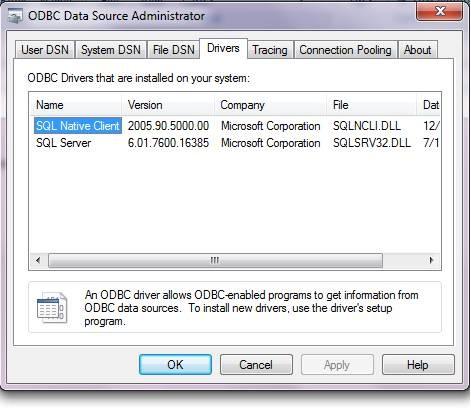If you are planning to upgrade your ConfigMgr infrastructure to the latest 1810 release, plan for updating the SQL Server Native Client to support TLS 1.2. If the SQL Server native client isn't already updated, the prerequisite check will fail with below warning.
-->SNAC, or SQL Server Native Client, is a term that has been used interchangeably to refer to ODBC and OLE DB drivers for SQL Server.
Important
The SQL Server Native Client (SQLNCLI) remains deprecated and it is not recommended to use it for new development work. Instead, use the new Microsoft OLE DB Driver for SQL Server (MSOLEDBSQL) which will be updated with the most recent server features.
Note
For more information and to download the SNAC or ODBC Drivers, see the SNAC lifecycle explained blog post.For more information on ODBC Driver for SQL Server, see Microsoft ODBC Driver for SQL Server.
Information on the SQL Server Native Client features released with SQL Server 2012 (11.x), the last available version of SQL Server native Client:
ODBC in SQL Server Native Client supports three features that were added to standard ODBC in the Windows 7 SDK:
Asynchronous execution on connection-related operations. For more information, see Asynchronous Execution.
C Data Type Extensibility. For more information, see C Data Types in ODBC.
To support this feature in SQL Server Native Client, SQLGetDescField can return SQL_C_SS_TIME2 (for time types) or SQL_C_SS_TIMESTAMPOFFSET (for datetimeoffset) instead of SQL_C_BINARY, if your application uses ODBC 3.8. For more information, see Data Type Support for ODBC Date and Time Improvements.
Calling SQLGetData with a small buffer multiple times to retrieve a large parameter value. For more information, see Retrieving Output Parameters Using SQLGetData.
The following topics describe SQL Server Native Client behavior changes in SQL Server 2012 (11.x).
When calling ICommandWithParameters::SetParameterInfo, the value passed to the pwszName parameter must be a valid identifier. For more information, see ICommandWithParameters.
SQLDescribeParam will consistently return an ODBC specification conforming value. For more information, see SQLDescribeParam.
See also
Install SQL Server Native Client
SQL Server Native Client Features

Microsoft SQL Server Native Client 11.0 is installed when you install SQL Server 2016 (13.x).
There is no SQL Server 2016 Native Client. For more information, see SQL Server Native Client.
You can also get sqlncli.msi from the SQL Server 2012 Feature Pack web page. To download the most recent version of the SQL Server Native Client, go to Microsoft速 SQL Server速 2012 Feature Pack. If a previous version of SQL Server Native Client earlier than SQL Server 2012 is also installed on the computer, SQL Server Native Client 11.0 will be installed side-by-side with the earlier version.
The SQL Server Native Client files (sqlncli11.dll, sqlnclir11.rll, and s11ch_sqlncli.chm) are installed to the following location:
%SYSTEMROOT%system32
Note
All appropriate registry settings for the SQL Server Native Client OLE DB provider and the SQL Server Native Client ODBC driver are made as part of the installation process.
The SQL Server Native Client header and library files (sqlncli.h and sqlncli11.lib) are installed in the following location:
%PROGRAMFILES%Microsoft SQL Server110SDK
In addition to installing SQL Server Native Client as part of the SQL Server installation, there is also a redistributable installation program named sqlncli.msi, which can be found on the SQL Server installation disk in the following location: %CD%Setup.
You can distribute SQL Server Native Client through sqlncli.msi. You might have to install SQL Server Native Client when you deploy an application. One way to install multiple packages in what seems to the user to be a single installation is to use chainer and bootstrapper technology. For more information, see Authoring a Custom Bootstrapper Package for Visual Studio 2005 and Adding Custom Prerequisites.
Sql Server Native Client 11 Driver
The x64 and Itanium versions of sqlncli.msi also install the 32-bit version of SQL Server Native Client. If your application targets a platform other than the one it was developed on, you can download versions of sqlncli.msi for x64, Itanium, and x86 from the Microsoft Download Center.
When you invoke sqlncli.msi, only the client components are installed by default. The client components are files that support running an application that was developed using SQL Server Native Client. To also install the SDK components, specify ADDLOCAL=All on the command line. For example:
msiexec /i sqlncli.msi ADDLOCAL=ALL APPGUID={0CC618CE-F36A-415E-84B4-FB1BFF6967E1}
Silent Install
If you use the /passive, /qn, /qb, or /qr option with msiexec, you must also specify IACCEPTSQLNCLILICENSETERMS=YES, to explicitly indicate that you accept the terms of the end user license. This option must be specified in all capital letters.
Uninstalling SQL Server Native Client
Sql Server Native Client Download 2008
Because applications such as SQL Server server and the SQL Server tools depend on SQL Server Native Client, it is important not to uninstall SQL Server Native Client until all dependent applications are uninstalled. To provider users with a warning that your application depends on SQL Server Native Client, use the APPGUID install option in your MSI, as follows:
msiexec /i sqlncli.msi APPGUID={0CC618CE-F36A-415E-84B4-FB1BFF6967E1}
The value passed to APPGUID is your specific product code. A product code must be created when using Microsoft Installer to bundle your application setup program.
See Also
Sql Server Native Client Download Windows 2012 R2
Building Applications with SQL Server Native Client
Installation How-to Topics